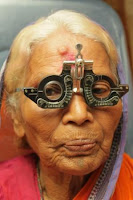What Is It?
As we age, the lens of the eye becomes increasingly inflexible, making it increasingly harder to focus clearly on near objects. This is called presbyopia. No one knows exactly what causes the lens to become inflexible, but it happens to everyone as a natural part of aging.
In order for us to see images clearly, light rays enter the eye, where the lens bends and focuses the rays on the retina. The lens changes shape to allow the eye to focu on objects at different distances. Beginning early in life perhaps as early as age 10 our lenses gradually stiffen and begin to lose the ability to change shape. By the time we are in our 40s, the lens has trouble focusing on close, and we begin to experience blurred vision when we try to do tasks that require up-close focus, such as reading or needlework. The lens continues to stiffen until about age 65, when nearly all its flexibility has been lost.
Presbyopia eventually affects everyone, even people who are already farsighted (hyperopic) or nearsighted (myopic). Because people who are farsighted already have difficulty focusing on near objects, they may experience presbyopia a little earlier in life. People who are nearsighted may find that their distance vision improves slightly, and may experience presbyopia a few years later in life.
Symptoms
Presbyopia causes the following symptoms:
- Words appear blurred at a reading distance that used to be comfortable.
- Reading material or other objects must be held farther away from your eyes to gain clarity or see details.
- Brighter light is needed to see clearly (bright light constricts the pupils, which changes the focus of the light on the retina).
- You have difficulty reading late at night, or when you are tired or stressed.
- Your eyes become uncomfortable, or you become tired or drowsy when doing close work because of the strain of eye muscles working to change the lens shape.
- You may have headaches as a result of muscle tension.
Diagnosis
Many people over age 40 diagnose presbyopia themselves based on their inability to read clearly at a distance that used to be natural and comfortable. Because the condition comes on gradually over many years, most people don't notice small vision changes and delay seeking professional help until the focusing problems interfere with daily life. Many optometrists joke that patients seek help only when their arms become "too short," unable to hold printed pages far enough away to see clearly.
Presbyopia can be diagnosed by an optometrist, ophthalmologist or physician, who will take a complete medical history to determine the extent of your vision problem. He or she will test your vision by having you read text at a distance that is typically comfortable to you. If the doctor diagnoses presbyopia, he or she will do a test to determine the extent of the focusing problem and the appropriate lens prescription. In this test, the doctor has you look through corrective lenses, and continues to increase the magnification power until the words on the page are clear to you and you are comfortable reading.
Expected Duration
Presbyopia cannot be reversed and gets worse as we get older. Vision changes stop around age 65.
Prevention
Nothing can be done to prevent presbyopia. It is an inevitable part of aging. However, people who do a lot of close visual work, such as working with a computer or intensive reading, may develop presbyopia earlier than others. If you do close work, take a 10-minute break every one to two hours to relieve strain on the eyes. Allow your eyes to focus on objects at a middle or long distance away to give your eyes a rest from close focusing. Be sure to use bright lighting when reading to help your eyes focus.
Treatment
Presbyopia can be treated with corrective lenses. Glasses are the simplest way to regain your ability to see close objects clearly. If you already wear corrective lenses for nearsightedness or farsightedness you may need two sets of glasses one for distance vision and one for close vision or glasses with bifocal lenses, in which the upper portion of the glass corrects for distance and the lower portion for near vision. Your optometrist or vision professional can order the appropriate prescriptions.
Standard, off-the-rack reading glasses may not be right for everyone. Contact lenses also can be used to treat presbyopia, although many people find it difficult to adjust to them. Bifocal contact lenses can be made, or you can get monovision lenses, in which one eye has a contact lens with a prescription for distance vision, and the other eye has a contact lens for up-close vision.





